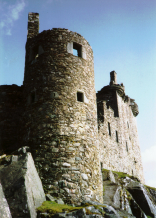Mary Lamont 1662
text from Scotland's Wicked Witches
Another case of 1662 involved the teenager, Mary Lamont (or Lawmont in documents). Mary was accused of witchcraft, along with Margaret Duff and others, from the parish of Inverkip in the west of Scotland.
Part of her case involved an interesting collision between different belief systems: Christian, diabolic and what might be called traditional, the latter perhaps harking back to a pagan or at least a pre-Christian or at least non-Christian origin.
Much of Mary’s apparent confession of 1662 consisted of elements found in other accusations, although she was quite young when her reputed wickedness first asserted itself and that would make the case memorable in itself.
Mary was from the Greenock or Gourock area, and she was about thirteen when she claimed she embarked on her career of malefice. Accusations included renunciation of her Christian faith and being baptised by Satan with the name ‘Clowts’, stealing milk by magical means, and shape shifting into a cat.
She also apparently confessed to having sex with the Devil several times when he appeared to her in the form of a large brown dog, marks being left on her when the demonic animal nipped her side.
She also confessed to, along with a group of other witches, trying to throw the Kempock Stone into the sea to sink ships in the Firth of Clyde and bring catastrophe to the fishing fleet.
The Kempock Stone, now widely known as Granny Kempock Stone, although formerly as Lang Stane, stands on Kempock Point at Gourock on the southern shore of the Firth of Clyde, and is a six-foot high standing stone.
It can be reached up a winding flight of narrow steps from Gourock’s main shopping street. The stone bears a (little) resemblance to an old hunched woman wearing a hood, hence its name Granny. Good luck rituals were associated with the stone, and it was used by both fishermen and by newly wed couples.
The ritual involved fetching a bucket of sand from the beach, then walking around the stone seven times withershins (anti-sunwise) with the bucket while chanting and singing. Fishermen performed the ritual to ensure good weather, a favourable wind, and a large catch of fish, while betrothed couples or newly weds hoped for a fruitful marriage with lots of healthy children.
In truth, this ritual would have been frowned upon by the church of seventeenth-century Scotland, and in many parishes this kind of practice, such as visiting shrines and wells, was deliberately discouraged and even prevented, being thought of (at best) as superstitious.
It is not clear what the nature of the chanted verse was, but if this was interpreted as an incantation, this ritual could have been seen as witchcraft and those taking part prosecuted for malefice.
That Mary and her companions, and by implication the Devil, might try to get rid of the Granny Kempock Stone is interesting in that it suggests the power of the stone was not in the domain of either Satan or of Christ.
Although the official records are missing or lost, Mary Lamont, Margaret Duff and others of the accused were most likely found guilty of witchcraft and were executed.
Some say that an apparition of Mary, accompanied by the Devil, can still be seen some nights during the full moon, dancing around Granny Kempock Stone.
© Martin Coventry 2017








